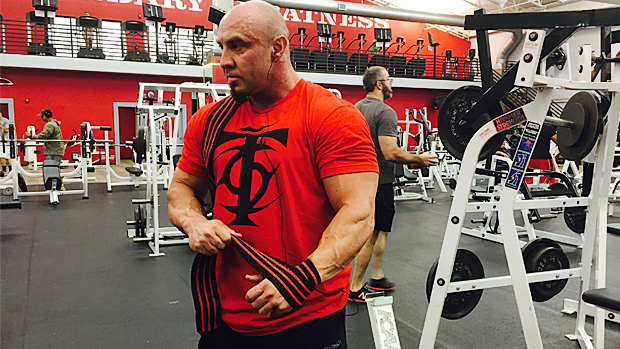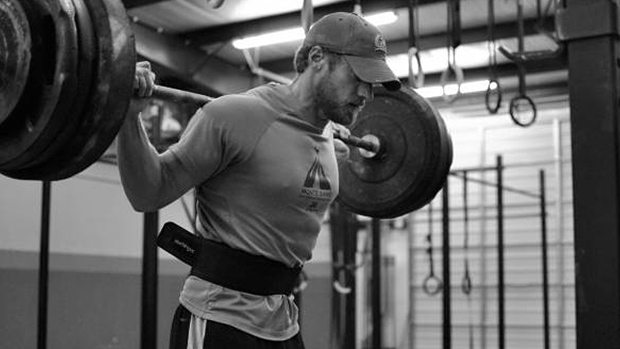To continually make progress, you must develop a set of training principles that keep you moving forward. The number of principles that make up a sound training program are few. Here's what they are and how to apply them to your own goals in the gym.
It needs to be exact, realistic, and limited. It also needs to make sense in the context of your life. Saying "I want to lose weight" is not a goal. It's an idea – a desire. Desires are the wellspring from which we can conceive a goal, but they aren't specific enough. Put more thought into it.
People put more thought into ordering a pizza than they do their physique or strength goals. Desires lack exactness. Goals are clearly defined. They're also limited. Wanting to get cut, huge, strong, and build bigger arms, traps, calves, and quads means you're going to lay out a program trying to give each of those things attention... which of course means attaining them all will never happen. So narrow down your goals to figure out what your program will look like.
Be realistic. Setting a small goal that's attainable will build confidence and pave the way to attaining more lifelong goals. Put a timeframe on them too. "I want to gain 15 pounds of muscle in 3 weeks" is dumb. It's dumb because muscle can't synthesize at that rate. Go do this for me: Buy 15 pounds of lean flank steak at the store, then lay that out on the table. Take a look at how much lean mass that is.
Imagine what all you would have to do for your body to create that much new muscle mass. Now consider your timeframe in regards to your goals, and start thinking about the other aspects you must put together in order to get that 15 pounds of flank steak on your body.
Don't forget about the context of your life. The guy competing for gold at the Olympics has different life circumstances than the guy that's working all day delivering furniture for people. If you're an air traffic controller, one of the most stressful jobs that exists, then you have to account for the toll that takes on your recovery. So trying to train twice a day isn't the best idea.
If you have a low stress job that's not physically demanding then your options are more open. Stress is stress, from a systemic standpoint. So the guy with the physically or mentally demanding job will probably need a different training model than the guy with a physically and mentally low-stress job.
There are three variables involved in training: volume, frequency, and intensity. Pick two to manipulate in order for you to meet your personal demands for recovery.
- Frequency is how many times a day or week you plan on training.
- Intensity has two variables. It can be the load on the bar or how difficult the set was (often defined by something like RPE, or rate of perceived exertion).
- Volume is your total workload per training session. There's a myriad of ways to measure volume, but let's keep this as simple as sets and reps.
The body has a limited degree of reserves to draw from, and when these get tapped out progress will grind to a halt. This will vary from person to person, which is why some people can grow by training three times a week with little volume and heavy weights, and others need a totally different style. So decide if you want to...
- Train more frequently – Work out most days a week
- Train with high intensity – Go heavy or do hard sets close to failure (or both)
- Train with high volume – Use a high amount of sets, reps, and exercises
Pick two of the options you enjoy the most, and down-regulate the third. If you love being in the gym daily, and like training balls-out, then keep your volume on the low side. If going to the gym daily doesn't appeal to you, find some middle ground and train 3-4 times a week.
From there decide if you want to train with a lot of volume, or if you want to train really heavy, or with a high degree of RPE per set. If your training frequency is somewhere in the middle then push either the volume high, with a lower degree of intensity, or push the intensity high with lower volume. Without recovery from the training stimulus, you cannot grow. There's no way around this.
All of these variables have a point of diminishing returns. People often get in the mindset of, "If 8 sets are good, then 12 sets will be great!" Then progress stalls and, believe it or not, they think they need to do more. Same for adding weight to the bar, or the number of training sessions per week. Once you get these all dialed in and progress is happening, don't screw around with believing that there's a more optimal way. Progress at 5% is better than no progress or regression. And at times, 5% progression is as much as you'll be able to get.
It's possible to get strong and build mass at the same time, but the two have some very unique differences. That means maximizing one requires limiting the other.
Building maximal strength has a large neural association with it. Repeated efforts and specificity are a big part of building a particular lift. So if strength is your main goal, then decide on that and build your program around the lift(s) you want to improve the most. A large degree of your time and energy in the gym will need to be spent just doing those lifts, to maximize efficiency with them.
Lower reps with a high degree of speed and large amounts of volume are often best when trying to accomplish this task. But if you're chasing numbers, you'll need to decide how you're going to set that phase up. Here are some examples for the big three:
- Squats: 5 sets of 8 at 65-70% of 1RM
- Deadlifts: 3 sets of 3 at 75-80% of 1RM
- Bench Press: 5 sets of 8 at 70% with 1-2 back-off sets at a reduced intensity (say 60%) for as many reps as possible.
On the other hand, if you want to get as massive as possible, you must learn to isolate muscle groups effectively, feel the muscle do the work, and create as much tension as possible in the area that you're working. There's a huge difference in these two ideologies. A bodybuilder doing bench presses will try to feel the pecs doing the work. If building mass is the goal, then moving maximal weight for 1-3 reps is not the most efficient method.
For hypertrophy, do 3-5 sets of 8-12 for upper body work, and 3-5 sets of 12-20 reps for lower body work (after warm ups, of course). This is just an example of a size-focused program, not a hard and fast rule. You may also benefit from things like 100-rep sets, depending on what the movement is and what you're trying to accomplish. Try starting with 4-6 exercises per training session to address areas you feel need the most work.
Determine what to focus on first so you can program and plan accordingly. Base your entire training structure around one: mass or strength. Not both. And if you want to switch later, do it.

Everyone adapts to training stimulus at different rates. If there's no change in your training plan after full adaptation is reached, then all that you'll get is fatigue. Each workout will be nothing more than achieving tiredness. If you aren't giving your body a reason to grow it's not going to. So it's important to know when to make small changes in order to create a new stimulus for growth or improvement.
If you go three sessions without an improvement in performance for a certain exercise, drop it and switch it out for something different. So if you plateau on lying leg curls and can't do more reps with a certain weight after three workouts, you'd go to seated leg curls, or standing leg curls. It doesn't seem like much, but those minor differences can spur new progress.
You don't need to overhaul a program that's largely working when a few lifts have stalled. Simply changing your hand placement or foot stance in an exercise may be all you need. The worst thing you can do is overhaul an entire program that's producing results. Keep what's working and make minor adjustments to what's not.
Assess every six weeks, check your training log (yes, you should be keeping one) and decide if changes need to be made. I've had training programs that I used for very long periods of time with no changes because progress was consistent. I've also had training programs that I stalled out on quickly in every aspect because they violated the principles of frequency, intensity, and volume.
If you have one or two really bad training sessions don't sweat it. But if you have three or four sessions where things have stalled with a movement, then make a small change. If your entire program feels like it has stalled, take a short deload, regroup, and decide where to go from there based on these principles.
Heart health, body composition, and work capacity are three reasons for conditioning. The third – work capacity – is often overlooked by powerlifters and bodybuilders. Being in good shape allows you to do more work in the gym in less time and recover faster.
I'm tired of the debate between the types of conditioning you should be doing. Some people say that steady state cardio is worthless. Others say interval training is the only way to go. They both have merit based on two words: It depends. Are you two weeks out from a bodybuilding show? Then that's probably not a great time to be running 100-yard hill sprints. Are you getting ready for two-a-days for football camp? Maybe interval training would be a good choice.
Try taking 45-minute walks because it's relaxing to both the body and mind, and will be easy on your joints. Or do intervals because it means less time messing with conditioning while still getting the benefits. Whichever you decide on doing, make sure that you enjoy your selection, and if you don't, at least make sure you won't be doing it much and that it meets the needs for your desired goals.
Your frequency of conditioning also depends. If losing fat is a primary goal and you need to do more cardio, I'd recommend more steady state with an interval session thrown in now and again. If you just want to get conditioning in twice a week then either is fine.
When you lay out your program, ask yourself why you're selecting certain movements, why you're doing so many sets and reps with them, and what the purpose is for the way you're going to be executing each movement.
If you're moving a weight fast with explosiveness, then it should mean you're doing so to teach the body to move bigger weights with more speed and power. If you're doing things in a controlled and deliberate fashion, then you're doing that movement in that manner for entirely different reasons.
Picking exercises aimlessly is the hallmark of the lifter who has no idea what he's doing. That or he's just copying someone else and doing it because they are. Create a program that's tailor-made for your needs and goals.
If you're a novice you really have no business doing upside-down cable crossovers in order to "build that inner chest, bro." Place your focus on doing the big lifts, perfecting technique, and progressive overload (adding more weight to the bar and/or reps to those weights). This is where the greatest amount of your effort should be.
This is also one of the few times where you can violate the volume-frequency-intensity-recovery rules because the fact is, you're just not strong or proficient enough at creating the kind of tension and stress that would leave you unable to recover.
If you're very advanced, then you probably have a handle on what you can or can't tolerate. But it behooves the advanced athlete to question himself on a continual basis because as he gets closer to his genetic ceiling then his training ideology may need to change in order for him or her to eek out the last bit of potential from training.
It's not just genetics or drug use that sets the elite apart from the average, but their intuition or ability to gravitate towards training ideologies that work best for them. In a way, lifting must speak to your training soul.
A program must resonate with you so that it elicits passion and desire from within. Because when it does, you work hard and you're consistent. You're probably not going to work hard or give consistent effort to a training program that you don't believe in.
It's about passion and desire. If someone has a significant degree of these, then they'll probably get significant results... even if, on paper, that training program doesn't look like it makes a lot of sense. Someone could give you the most perfect training plan based on studies and science, and if you hate it, the results will be less than optimal because your heart isn't in it. It's the intangible part of training that science and studies can't account for. You must design a training program that resonates with your goals, needs, and who you are.
Desire creates a need. And from that need hard work and consistency are born. A program is only as good as the amount of heart you're putting into it.





